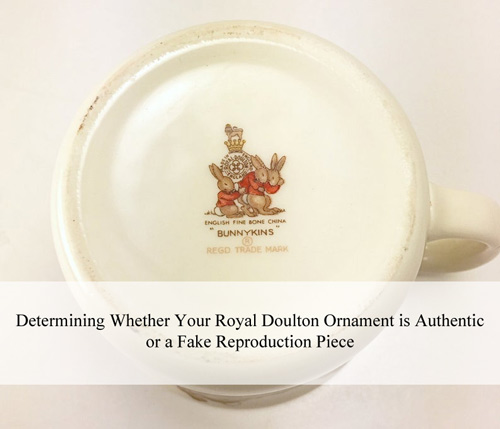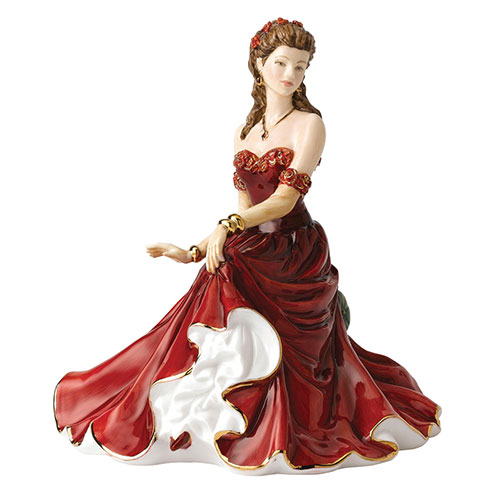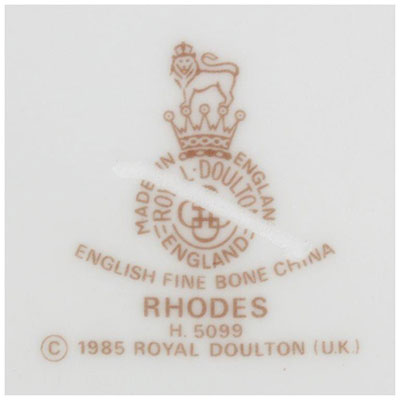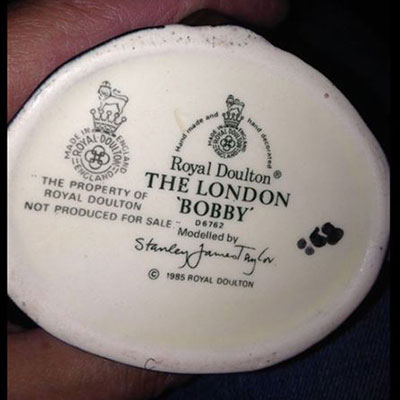The very first thing that any Royal Doulton collector needs to be aware of, is that the company also releases seconds. This can make it difficult for some collectors to determine if a piece is a genuine Royal Doulton or a cleverly produced replica.

To help alleviate some of the confusion that Royal Doulton seconds can create, this article will be covering the types of markings that could indicate if a piece is a genuine piece or not.

Contents
What is a Royal Doulton Second?

As a brand and as a company, Royal Doulton has become synonymous with excellence thanks to the high-quality chinaware and porcelain products that they have produced over the decades.
If a piece fails any of the company’s quality control proceeders at any point, it is either destroyed or marked off as a seconds piece.
This isn’t to say that a piece that has been marked off as a second has a major flaw in its structure. A seconds piece will not break more easily, nor are they missing a physical feature of some description.
All seconds that are released by the company, must still pass the same quality assurance when curing and fired, as any other piece. This means that the same fine details that are found on their figurines will still be there. The chinaware will still have the same thickness and density as every other piece from the series.
What makes a Royal Doulton a seconds, is the fact that the finish is not right. The pattern might be off, there might be paint in the wrong area, or the finishing gloss may have even pooled in one spot, hardening off into a lump.
This makes every Royal Doulton seconds still a genuine piece. They just happen to have a blemish here or there that fails to meet the high-quality standards that the company is known for.
How to Tell If a Piece Has Been Earmarked as a Seconds?
With a few exceptions here and there, every single piece that has been released by the Royal Doulton Company will have the Trade Mark that was in use at the time, used as the back stamp for the piece. Yes, this even includes seconds pieces.
Whenever a piece fails the final quality control inspection a deliberate mark is made into the backstamp/trademark. These marking are clearly deliberate and not part of general wear and tear.
Look For a Hole Drilled Into the Trademark
The first and most common seconds indicator is a small hole that is drilled through the center of the trademark. These holes will be small, neat and tidy, and can be easily overlooked. What makes them an obvious intentional marking, is that the hole will be near the center of the trademark.
Look For a Line That has Been Scored Across the Trademark
The second, less common method, is a line that has been deliberately scored into the back of the piece. Depending on the particular piece in question and the trademark that is present, there are two different methods that were used to score the piece to indicate it as a seconds.
One method was to score a horizontal line through the words ‘Royal Doulton”. The other method was to score the line diagonally across the entire trademark. What makes it clear that these are obviously intentional scorings, is that the lines will be clean and straight, running from end to end, and too precise to be an accidental scratch.
Are Seconds As Valuable As Other Pieces from the Same Series?
Generally speaking, no. Most seconds are not as valuable as other pieces that have cleared Royal Doulton’s quality control inspections. Even though they may be genuine Royal Doultons, most collectors are not interested in these seconds/rejects.
Even Royal Doulton themselves do not hold value for the pieces that have failed their high-quality insurance tests. This is why they sold these pieces at a heavily discounted rate, if at all.
But that isn’t to say that there are no collectors out there who hold a special interest in Royal Doulton seconds. They’re just not as common as the collectors of the pristinely finished Royal Doulton wares.
How to Look for a Genuine Royal Doulton Piece

First things first, make sure you know what type of collection the piece you are looking at is from. Is it a Figurine? Or is it a Character Jug or Toby Jug, a Decorative Plate, Dinnerware, or Series Ware? All of these different collections all carry their own methods of identification.
Pieces that are meant to convey character, or have an identity that is uniquely their own, namely Figurines and Character or Toby Jugs, will have their name, branded on the bottom/underside of the piece along with an identification number, and the trademark logo for that period of production.
Depending on the age of the piece, the name and numbers may have been hand-painted or printed. Knowing these little details can help you to identify a genuine piece from a fake.
Inspect the Painting Methods
Modern reproductions need to be made on the cheap. Complete counterfeits are often made out of cheaper, inferior materials. This even includes the paints they use, the color and vibrancy, as well as the painting and labeling methods needed to reproduce the product.
It is important that you familiarize yourself with the type of paintwork and finish that the piece from a collection is meant to have. A true Royal Doulton piece would not have run lines, the paint would not be translucent or watered down, and the edges along the paint would not form a hard edge that could be easily felt and/or gripped.
If a piece was meant to be handpainted and have written identification marks, look for signs of brushwork in the paint itself. Hand-painted writing also has its own telltale signs. When signing something by hand, or painting letters or numbers in general, the paint tends to be thickest where the brush first starts the stroke, thinning out towards the end of the stroke.
Dipped, or sprayed on paint looks very different from paint that has been applied by brush. There may be signs of rippling in the paint. Hard or uneven edges may develop where the paint ends. You may even see dots that have formed where paint mist has settled in places where it’s not meant to have.
Compare the Pattern and Design with Known Genuine Examples
Not all forgeries are obviously fake. That is why it is very important to check any piece that you are not sure about, against other pieces that have been confirmed to be genuine.
There is one very notorious method that has been used by counterfeiters to catch many an unsuspecting victim. Instead of making a piece from scratch, the forgery is made by taking a piece that was made by another company such as Moorcroft, Clarice Cliff, Royal Albert, Royal Worcester, or Beswick and passing them off as a Royal Doulton by rebranding the piece with an authentic-looking, albeit fake, Royal Doulton trademark logo.
To do this, the original trademark is sanded off before they add the authentic-looking Royal Douton trademark. Sometimes all that they’ll do is replace the original trademark with the counterfeit trademark. Other times they may even repaint the piece in an attempt to make it look more like something that Royal Doulton would produce.
You may even find yourself with an original Royal Doulton piece that has been repainted to make it look like a more expensive piece or genuine prototype. The original Royal Doulton trademark may even be replaced with an older trademark.
How to Tell If the Trademark Is a Fake
Many of the fake trademarks that are out there look almost authentic. One sign that the trademark could be a forgery, is the presence of a yellow tinge that has formed around the trademark. Other signs to look out for are:
- Poorly replaced or disguised trademarks
- Does the original trademark still show through?
- Are there noticeable scratches that are visible under the glaze?
- Is the glaze finish around the trademark not as glossy as it is anywhere else on the base?
- Has the trademark fully adhere to the base, or is part of it missing?
- Is the trademark smudged?
- If the base was reglazed, there may be a notable difference between the finish or color of the glaze on the bottom of the base compared to the sides of the base.
- If the piece is meant to be several centuries old, how new does the base look? If the base is pristine and flawless, it may have been touched up recently.
- Feel the surface around the trademark. If the area around the trademark feels lower than the rest of the base, then it may be likely that that area of the base has been sanded down.
- Are there one or two Royal Doulton trademarks on the base?
In the event that two Royal Doulton trademarks are present, it may be an attempt to try and pass a piece off as a unique and genuine piece. In many cases, the second trademark has been added to try and justify why a piece has a unique color pallet, by incorporating wording along the lines of:
FOR MARKET RESEARCH PURPOSE ONLY
NOT FOR SALETHE PROPERTY OF ROYAL DOULTON
NOT PRODUCED FOR SALEPROTOTYPE ONLY
What Should You Do if You Suspect a Forgery?
If you see something that doesn’t look right with the trademark logo, the paintwork, the coloring of the paint or glaze, or even if you can’t find another collection that the piece might belong to; then chances are that you may very well have a forgery on your hands.
In short, if you don’t feel as though you can trust the seller, or have genuine concerns about the authenticity of the piece, then just don’t buy it. Counterfeiters bank on a collector’s desire to acquire the rarest of rare pieces at a bargain price, to push their shady goods.
If the seller is willing, have the piece appraised by an expert. If they are unwilling to let someone take a look at the item for you, then there may be a problem with it.
Remember, it is your hard-earnt money, and if you were to buy a fake Royal Doulton from a less then reputable dealer, you may not be able to get your money back.
Leave a Reply